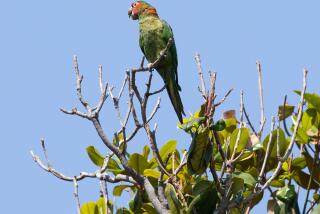Coup d’<i> Etat</i> : It’s Time to Change Our Unkind View of the Common, but Innocent, Pigeon
- Share via
READER JOHN Degatina, who seems to have time to worry about a number of today’s lesser problems, is worried now about the image of that most common and imperturbable of birds, the pigeon.
I know there are many species of pigeon, but when I say pigeon I mean pigeon . The kind we see everywhere in parks. The kind that scramble for crumbs and roost on top of statues’ heads. I will bet you even money that at any given moment there is a pigeon on Beethoven’s head in Pershing Square. Also on Lafayette’s in Lafayette Park.
Degatina complains that his “uppity” bird-watcher friends call pigeons “junk birds,” and he points out the numerous uses of pigeon in common terms for unheroic human traits.
For example, a pigeon-hearted person is a coward; a pigeon-livered person is a nerd; a pigeon-toed person walks with toes turned in; to pigeonhole something is to categorize it, lay it aside and ignore it; a pigeon is a con man’s dupe.
In our arrogance, of course, we often use animals as metaphors for disagreeable people: a fool is an ass, a gourmand a pig, a cad a snake, a victim a goat, a gossipy woman a cat, a womanizer an insect, a predator a wolf, a dandy a peacock, a foolish person a goose, a sadist a reptile, a gentle woman a dove, a vicious man a dog, a brute an ape--to name but a few.
Evidently Degatina’s point is that pigeons deserve more respect.
I agree. Nuisances though they may sometimes be, pigeons have certainly added life and natural beauty to the urban scene. What would the Piazza San Marco in Venice be without its pigeons, or Trafalgar Square in London? Or Pershing Square, for that matter? What couple on tour does not come home with snapshots of each other smiling in a cloud of pigeons?
Of course, pigeons are scorned or ignored by ambitious bird watchers because they are so common. They are the first bird on every birder’s list, and once a birder has added a bird to his list he tends to lose interest in it.
Pigeons were among the first of man’s animal friends. They are found on coins dating back as far as 4500 BC. They have been used as messengers, in war and peace, for millennia. Before the telephone cable was laid, pigeons carried the news between the mainland and Catalina Island. They have also been eaten.
Of all the stories of man’s cruelty to his feathered friends, none is meaner than that of the passenger pigeon. Billions of this beautiful species inhabited eastern North America in the early 19th Century. They were so numerous, according to Encyclopaedia Britannica, that sometimes “migrating flocks darkened the skies for days.” As settlers moved westward, they shot these birds by the millions for their own tables and for urban markets. Carloads were shipped to cities by rail. On Sept. 1, 1914, the last passenger pigeon died in the Cincinnati Zoo.
In a Wisconsin state park, a monument to the passenger pigeon bears the legend: “This species became extinct through the avarice and thoughtlessness of man.”
That is undoubtedly what Samuel Eliot Morison had in mind when he wrote of the Yankee Clipper ships that “for a brief moment of time . . . flashed their splendor around the world, then disappeared with the sudden completeness of the wild pigeon.”
No prettier lines have ever been written about pigeons than in “Sunday Morning” by Wallace Stevens: In the isolation of the sky, At evening, casual flocks of pigeons make Ambiguous undulations as they sink, Downward to darkness on extended wings.
And Gertrude Stein, with her usual ambiguity, penned the immortal line: “Pigeons on the grass alas.”
A few years ago our backyard was visited daily by a dozen large pigeons that clung to the tiny perches on our finch feeder and hogged all the seed. They were not the urban domesticated birds of Pershing Square but the wild band-tailed pigeons. Evidently, they had come down from the San Gabriel Mountains to winter in the foothills and had made it all the way to Mt. Washington, only five miles from City Hall.
I hope they are still around.
More to Read
Sign up for The Wild
We’ll help you find the best places to hike, bike and run, as well as the perfect silent spots for meditation and yoga.
You may occasionally receive promotional content from the Los Angeles Times.






